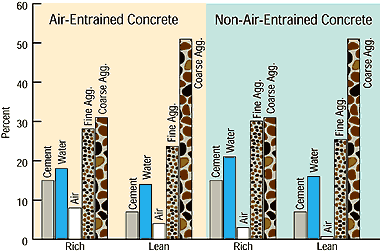Concrete: Difference between revisions
Jump to navigation
Jump to search
| Line 10: | Line 10: | ||
*Lean is used below foundations - and is 700 psi or 1100 psi [https://wecivilengineers.wordpress.com/2018/04/01/what-is-lean-concrete-where-it-is-used/] | *Lean is used below foundations - and is 700 psi or 1100 psi [https://wecivilengineers.wordpress.com/2018/04/01/what-is-lean-concrete-where-it-is-used/] | ||
=Slab Requirements= | =Slab Requirements= | ||
*2500 PSI concrete minimum for slab on grade in Oregon - [https://www.co.douglas.or.us/building/INSPECT.gen.residential.info.htm] | *2500 PSI concrete minimum for slab on grade in Oregon - [https://www.co.douglas.or.us/building/INSPECT.gen.residential.info.htm] and Georgia [https://up.codes/viewer/georgia/irc-2012/chapter/4/foundations#4] | ||
=Concrete Slump Testu= | =Concrete Slump Testu= | ||
Revision as of 04:44, 10 December 2020
Formula
- 10% cement, 75% aggregate, 15% water [1]
- 150 kg/m3 of cement - with concrete at 4000 lb/cu yd [2] - was sufficient to get about 6000 psi concrete strength [3]. Does this mean abouut 8% of cement?
- 500 lb per yard of cement in concrete is recommended - read a thesis on it - [4]
- Lean or rich: 7-15% cement by volume -
- Lean concrete per california codes is 300 lb cement per yard of concrete, and is 700 PSI at 7 days. [5]
- Lean is used below foundations - and is 700 psi or 1100 psi [6]
Slab Requirements
Concrete Slump Testu
Measures inches of collapse, from 0-12", of a wad of concrete in a cone. 12" means it's complete water. 4" is very stiff.
